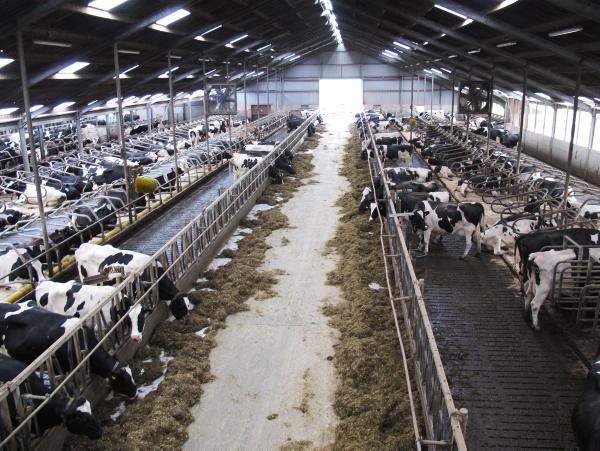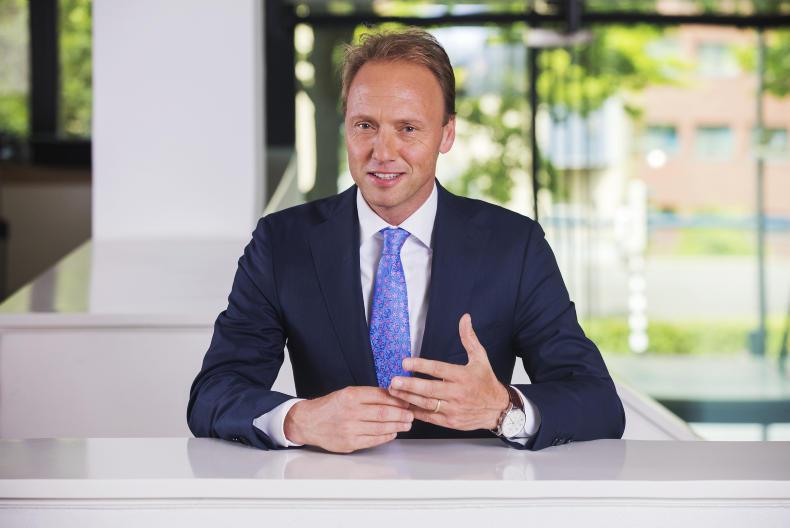Jildert Monkelbaan and his son are farming near Heerenveen in the north of the Netherlands. At the moment they are milking 260 cows and farming 150 hectares (370 acres) in total, milking twice a day with one labour unit employed. Jildert took over this farm in 1973 with 40 cows as a young and enthusiastic 25-year-old farmer. Even though he is now 66 years of age, recently the bank told him they would like to see him staying involved in the business for another while.
In 2004, 10 years ago, Jildert brought his son into the family farm business and now they work together as a family partnership. When this new partnership was created in 2004, they created a development plan for the farm that involved buying 80 hectares of land, buying milk quota and renovating the milking parlour and sheds. Jildert has another son and daughter in university.
The 260 Holstein Friesian cows remain indoors for the majority of the year but sometimes the herd and especially young stock get out for some grazing from July onwards.
The cow house is built for 350 head so the herd will expand once quotas go to fill the remaining places. How quickly this happens depends on replacement rates, workload, etc. There are 80 in-calf heifers and 90 calves on this farm also.
Production per cow is very good at 8,500kg of milk at 4.50% fat and 3.70% protein (700kg of milk solids per cow). Jildert said the farm milk price is 1.5 cent/litre above the Friesland Campina average milk price because of the high milk solids. Calving interval is 420 days and each year approximately 30% of the herd is replaced. Jildert said infertility and lameness are by far the two biggest reasons why cows leave the herd.
Feeding
Cows are mainly fed a mix of grass silage and maize. Some fresh grass is cut and brought into the cows on a daily basis but Jildert said this is mostly just for the low-yielding group of cows. He finds the grass very variable and yields go up and down when the cows are on grass and he didn’t find it suitable for a cow yielding 50 to 60 litres per day. When we took a walk to see the grass that was being cut, it was more like silage in Ireland, so obviously production would be reduced.
The farm grows 30 hectares of maize. Up until recently they were growing 38 hectares but the Dutch Nitrate Derogation stipulates that a farmer can only have 20% of the total area farmed in tillage, so the maize area for this farm had to be reduced. The rest of the area farmed, 120 grassland hectares, is cut mostly for silage and the maximum amount of bag nitrogen they can spread is 160kg/hectare.
When asked about what the extra cows would be fed post-2015, the Monkelbaans suggested that at the moment they are selling silage so they already are producing the feed on farm and in future that would be fed rather than sold.
At the moment they estimate they are growing 12 to 14 tonnes of grass dry matter per hectare and most is harvested as grass silage.
Cows are fed in production groups with high-yielding cows averaging 40 litres per day, medium producers (later in lactation) averaging 25 litres per day, and low-yielders averaging 20 litres per day this week.
Figures
Friesland Campina’s current milk price for this farm is 43c/l but Jildert said concentrate cost alone accounts for 7c/l of production costs. Soyabean meal to balance the low protein maize silage is forward-bought annually and they are paying €320 per tonne rather than the €420 per tonne it would be if Jildert was buying from the spot market today.
The actual feed cost of grass/maize silage would easily be another 7-8c/l before machinery repayments, so that’s 14-15 c/l in total on feed costs alone. After that, all other production costs must be accounted for, such as machinery, health, fertilizer, labour, etc.
It’s fair to say, like all Dutch farmers, there is a strong love affair with machinery. When I walked out of the cow shed, Jildert showed me his new feeder wagon.
Better again, around the corner there was a mower loaded on a front A frame of a Fendt and behind that was a very high-spec Schuitemake grass wagon that can feed the grass out the back of the wagon to either side of the feed passage. It is fair to say the grass cutting unit would cost over €250,000 if a farmer went out to purchase it today (see video on www.farmersjournal.ie).
Around the next corner was a typical Dutch dairy farm machinery shed where two more Fendt tractors and all the associated kit involved in making silage, fertilizer and slurry were housed.
Only maize sowing and harvesting is contracted out on this farm, with the rest of the machinery work carried out by family labour and farm machinery.
Milking
The milking parlour is a 15-unit rapid-exit double-up parlour and Jildert explained the 260 cows were taking two hours and 30 minutes to milk at the moment, excluding washing up time. That’s an output of about 100 high-yielding cows per hour.
The farm employs one full-time labour unit who works 38 hours per week and some part-time labour at the weekends. The worker starts milking at 4.30am.
In total the labour cost is €24 per hour for 38 hours per week. Jildert’s son is working on the farm full-time, starting at 5.30 each morning, and Jildert milks himself twice per week while his wife feeds and looks after the calves.
Local women living close to the farm milk the cows at weekends. When I asked about the number of hours worked, Jildert said: “Yes, we work hard but we have a good life. I have a pension so I’m not expecting much income from the farm. All proceeds belong to the next generation and the bank at the moment.”
Debt
The investment on farm in cow housing and machinery is exceptional. Over 6,000 cubic metres of slurry is stored under the cubicle shed and two-thirds of the cubicles are water beds with the balance mattresses. Calves are fed replacer on an automatic feeder, hay and a lucerne-based nut.
We discussed farm borrowings and debt levels. The farm paid €150,000 in capital loan repayments last year (3.3% of €4.5m debt). When discussed, the farmers were unperturbed by such an amount of debt but realised it was a large amount (over €17,000/cow).
The farm plan involved milking more cows post-quota so while the capital investment had been made, the Monkelbaans (like most Dutch farmers) are planning on producing more to dilute fixed costs further.
From other farmers we visited, it is clear the bank would allow capital loan repayments to be suspended if milk price did take a wobble downwards. What would happen if interest rates rose significantly would be a concern.
Kennedy’s view
We must remember that the Monkelbaan farm is producing a lot of milk and while there are only 260 cows being milked, each cow is producing almost twice the milk of your typical Irish spring milk cow, so we are talking about a 520 Irish spring cow equivalent farm in production terms.
While production costs must be close to 40c/litre the other factor to remember is that this farm and many other Dutch farms are dependent on family labour to a large extent, so these businesses have a small release valve and could ride a storm short-term but no family income would not be sustainable in the long term. Taking all this into account and not specifically talking about this farm, the Dutch dairy sector certainly has plenty of the signals the Irish property market had only a few short years ago.
Debt levels per farm theoretically stack up when land prices continue to rise at €40,000 per hectare. In Denmark, land values crashed when the price of land halved – could the same happen in the Netherlands?
Another fundamental difference is many farmers are allowed to put capital loan repayments on hold long-term with many also putting interest repayments on hold. Effectively the debt is passed onto the next generation and ownership structures evolve into family partnerships rather than sole traders.
While the industry has the main Dutch agri banker Rabobank on side, which is obviously a big help, one wonders will even they be able to sustain these high debt and investment levels on dairy farms.
The large Dutch dairy company Friesland Campina is delivering a very good milk price and bonuses but the Dutch dairy ethos seems to be to invest this on-farm rather than pay tax, meaning they must work harder to stand still – at best. Similar to other countries, there are different advisers for different aspects of the business with feed, breeding, animal health and fertilizer advisers calling to farms on a daily basis, clouding the investment decisions for farmers. There is no middle ground and all investment is under a roof with little or no investment in the fields.








SHARING OPTIONS